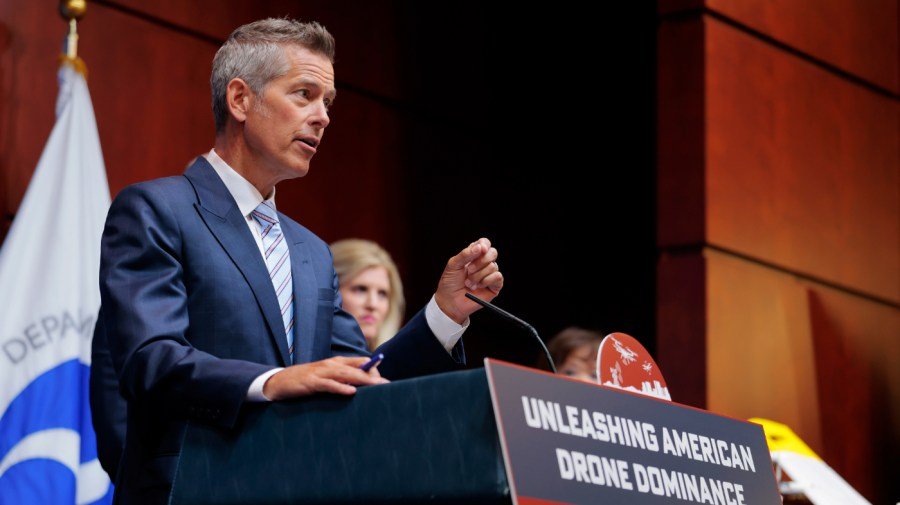
The naming of Secretary of Transportation Sean Duffy as interim NASA administrator was as much of a surprise as was President Trump’s withdrawal of his nomination of Jared Isaacman to the same post.
So, how is Duffy doing, trying to bring the space agency out from its summer of discontent?
Duffy has been spending a lot of his time boosting the Artemis program, designed to return astronauts to the moon and eventually send them to Mars.
On the social media platform X, he posted that he “spoke with the smart leaders of our mission directorates” and the consensus was “America MUST dominate space and our critical moon mission, #ARTEMIS, must be as known & supported by America just as Apollo was!”
He finished saying he was “fired up and ready to launch.”
Duffy repeated his advocacy of the Artemis program on the Fox News show Hannity. He noted that Artemis would proceed in three phases: a return to the moon, establishing a lunar base or outpost and crewed expeditions to Mars.
Considering how well the Artemis program polls, Duffy is pursuing a sound political strategy. The trick is that the steps he laid out have to happen on a sensible schedule. Fortunately, Artemis II, the crewed trip around the moon, is slated to occur early in 2026.
On the other hand, science journalist Robert Zimmerman gave Duffy the back of his hand for stating on Hannity that Artemis III, the next moon landing, is still a go for 2027. Considering the problems the SpaceX Starship has been having, few people believe that date is valid. However, SpaceX’s Gwynne Shotwell has assured Duffy that it is. We’ll see.
According to Politico, Duffy has called for a 100-kilowatt nuclear reactor to be deployed on the moon by 2030, to provide power for a lunar base.
He has also called for the acceleration of commercial space stations that would replace the International Space Station when it ends its operational life. The new plan promises to be very disruptive.
Duffy also had a meeting at the Kennedy Space Center with his Russian counterpart. Reuter’s Joey Roulette said the meeting discussed “‘cooperation on lunar programs’ and ‘joint exploration of deep space’ as well as ISS cooperation,” according to Roscosmos.
International Space Station cooperation is a natural topic of conversation between the head of NASA and the head of Roscosmos.
The United States and Russia have been partners on the space station since early in the Clinton administration. The partnership exists in its own little universe, separate from the tensions between the two countries brought about by Russia’s invasion of Ukraine.
Ars Technica reports that Bakanov brought up the possibility of using Russian hardware to deorbit the ISS in 2030. Clearly, he was attempting to take advantage of the feud between Trump and Elon Musk, whose SpaceX currently has the contract. Roscosmos would get a much-needed infusion of cash if it replaced SpaceX.
However, the mention of cooperation on lunar programs and the joint exploration of deep space catches the eye. Russia has turned down participation in the Artemis program, preferring to be a partner on China’s planned International Lunar Research Station.
Russian participation in Artemis was likely dangled as an enticement for Putin to make peace in Ukraine on terms short of conquering the entire country. It would also serve as a way to separate Russia from China, something that has been a center of American foreign policy since the Nixon administration.
Finally, Duffy has to deal with the NASA spending war that has developed between the Congress and the White House.
A group of Democratic senators sent him a letter expressing their concerns not only about the planned cuts for the next fiscal year but plans to rescind some allocated money for the current fiscal year. They are also concerned about a planned buyout program that would cut 4,000 NASA civil servants.
The Senate and House are concerned about NASA’s plans to implement the spending plans in the “big, beautiful bill.” They are demanding answers by Sept. 1.
Duffy will need the diplomatic skills of a Henry Kissinger to reconcile the positions of the two branches over NASA funding. As able as he is, the situation cries out for a permanent NASA administrator, someone with the respect of both President Trump and the Congress.
Otherwise, the chaos will just continue, hampering the space agency’s ability to fulfill its mandate to explore space, for the betterment of the United States and all humankind.
Mark R. Whittington, who writes frequently about space policy, has published a political study of space exploration entitled “Why is It So Hard to Go Back to the Moon?” as well as “The Moon, Mars and Beyond” and, most recently, “is America Going Back to the Moon” He blogs at Curmudgeons Corner.


